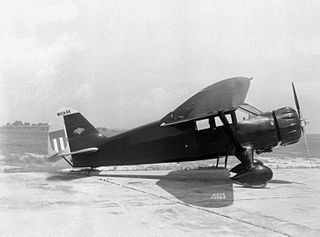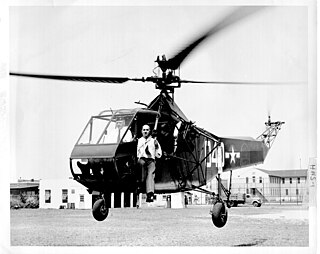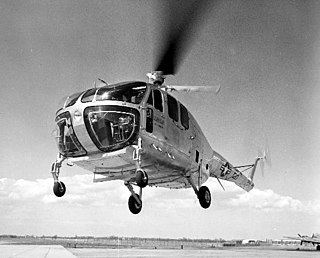Related Research Articles

The Boeing AH-64 Apache is an American twin-turboshaft attack helicopter with a tailwheel-type landing gear arrangement and a tandem cockpit for a crew of two. It features a nose-mounted sensor suite for target acquisition and night vision systems. It is armed with a 30 mm (1.18 in) M230 chain gun carried between the main landing gear, under the aircraft's forward fuselage, and four hardpoints mounted on stub-wing pylons for carrying armament and stores, typically a mixture of AGM-114 Hellfire missiles and Hydra 70 rocket pods. The AH-64 has significant systems redundancy to improve combat survivability.

The Bell OH-58 Kiowa is a family of single-engine, single-rotor, military helicopters used for observation, utility, and direct fire support. Bell Helicopter manufactured the OH-58 for the United States Army based on its Model 206A JetRanger helicopter. The OH-58 was in continuous U.S. Army service from 1969 to 2017, when it was replaced in these roles by the Boeing AH-64 Apache and Eurocopter UH-72 Lakota.

A liaison aircraft is a small, usually unarmed aircraft primarily used by military forces for artillery observation or transporting commanders and messages. The concept developed before World War II and included also battlefield reconnaissance, air ambulance, column control, light cargo delivery and similar duties. Able to operate from small, unimproved fields under primitive conditions, with STOL capabilities, most liaison aircraft were developed from, or were later used as general aviation aircraft. Both fixed-wing aircraft and helicopters can perform liaison duties.

An attack helicopter is an armed helicopter with the primary role of an attack aircraft, with the offensive capability of engaging ground targets such as enemy infantry, military vehicles and fortifications. Due to their heavy armament they are sometimes called helicopter gunships.

The Hughes OH-6 Cayuse is a single-engine light helicopter with a four-bladed main rotor used for personnel transport, escort and attack missions, and observation. Hughes Helicopters also developed the Model 369 as a civilian helicopter, and the Hughes Model 500, currently produced by MD Helicopters as the MD 500.

The Piper J-3 Cub is an American light aircraft that was built between 1938 and 1947 by Piper Aircraft. The aircraft has a simple, lightweight design which gives it good low-speed handling properties and short-field performance. The Cub is Piper Aircraft's most-produced model, with nearly 20,000 built in the United States. Its simplicity, affordability and popularity invokes comparisons to the Ford Model T automobile.

The Tri-Service aircraft designation system is a unified system introduced in 1962 by the United States Department of Defense for designating all U.S. military aircraft. Prior to then, the U.S. armed services used separate nomenclature systems.

The Stinson Reliant is a popular single-engine four- to five-seat high-wing monoplane manufactured by the Stinson Aircraft Division of the Aviation Manufacturing Corporation of Wayne, Michigan.

The Sikorsky R-4 is a two-seat helicopter designed by Igor Sikorsky with a single, three-bladed main rotor and powered by a radial engine. The R-4 was the world's first large-scale mass-produced helicopter and the first helicopter used by the United States Army Air Forces, the United States Navy, the United States Coast Guard and the United Kingdom's Royal Air Force and Royal Navy. In U.S. Navy and U.S. Coast Guard service, the helicopter was known as the Sikorsky HNS-1. In British service it was known as the Hoverfly.

The Fairchild Hiller FH-1100 is a single-engine, single two-bladed rotor, light helicopter which began as a design entry into the United States Army's Light Observation Helicopter program as the Hiller YOH-5. The Hiller Model 1100 was not selected but after Hiller Aircraft was purchased by Fairchild Stratos in 1964, the Model 1100 was successfully marketed as a civilian helicopter, the FH-1100. The type certificate is now held by the FH1100 Manufacturing Corporation of Century, Florida.

The Stinson L-1 Vigilant was a 1940s American light observation aircraft built by the Stinson Aircraft Company at Wayne, Michigan. The aircraft was operated by the United States Army Air Corps as the O-49 until 1942.

The Bell R-12 was an American 1940s military utility helicopter built by the Bell Helicopter company.

The Platt-LePage XR-1, also known by the company designation PL-3, was an early American transverse rotors helicopter, built by the Platt-LePage Aircraft Company of Eddystone, Pennsylvania. The winner of a United States Army Air Corps design competition held in early 1940, the XR-1 was the first helicopter tested by the USAAF, flying in 1941. The flight testing of the XR-1 proved troublesome, and although continued testing showed that the design had promise, other, improved helicopters were becoming available before the XR-1 was ready for service. As a result, the development of the aircraft was terminated in 1945.

The Firestone XR-9, also known by the company designation Model 45, was a 1940s American experimental helicopter built by the Firestone Aircraft Company for the United States Army Air Forces. Only two were built.
The Pace-Finletter MOU of 1952 was a memorandum of understanding (MOU) was signed on 4 November 1952 between United States Air Force Secretary Thomas K. Finletter and United States Army Secretary Frank Pace that removed the weight restrictions on helicopters that the U.S. Army could use. It also widened the range of tasks the Army's helicopters could be used for. However, it also created an arbitrary 5,000 pound weight restriction limit on the Army's ability to fly fixed-wing aircraft. As a result, the U.S. Army today is dependent upon the U.S. Air Force to purchase and man fixed-wing ground-attack aircraft to fulfill close air support missions.
"...that established a fixed wing weight limit of five thousand pounds empty, but weight restrictions on helicopters were eliminated ..."

The Bell XH-15 was an American four-seat utility helicopter designed and built by Bell Helicopter, to meet a requirement for a liaison and utility helicopter for the United States Army and United States Air Force.

The Sikorsky R-6 is an American light two-seat helicopter of the 1940s. In Royal Air Force and Royal Navy service, it was named the Hoverfly II.

The Ryan YO-51 Dragonfly was an observation aircraft designed and built by Ryan Aeronautical for the United States Army Air Corps (USAAC). A single-engined parasol wing monoplane, it was designed for optimum STOL capability, but although three prototypes proved highly successful in testing, the Stinson YO-49 was judged superior and no production contract was placed.
The Platt-LePage Aircraft Company was a manufacturer of aircraft for the armed forces of the United States of America. Based in Eddystone, Pennsylvania, the company produced the first helicopter to be officially acquired by the United States Army Air Forces.
References
- Notes
- Bibliography
- Andrade, John (1979). U.S. Military Aircraft Designations and Serials since 1909. Hinckley, Leicastershire, UK: Midland Counties Publications. p. 171. ISBN 0-904597-22-9.
- Merriam, Ray (2002). World War II Journal #15: U. S. Warplanes of World War II, Volume 1. Bennington, Vermont: Merriam Press. p. 64. ISBN 1-57638-167-6 . Retrieved 10 November 2011.